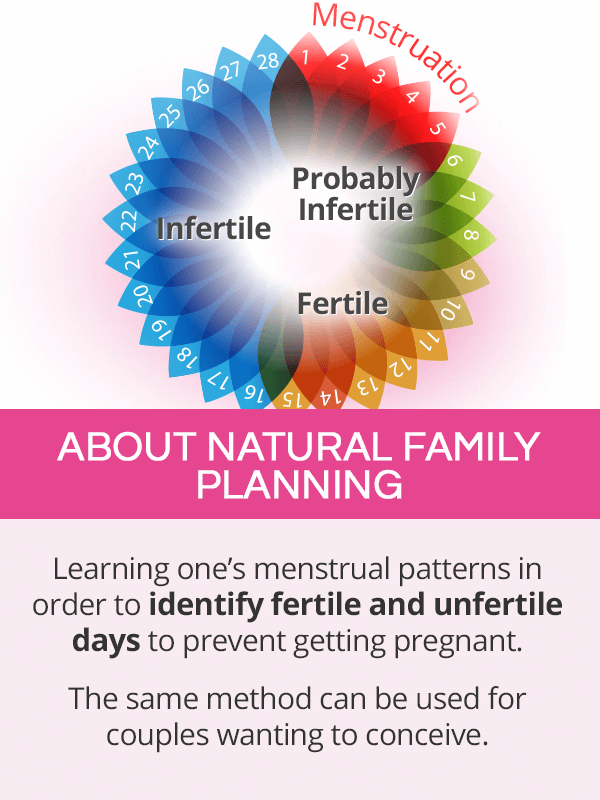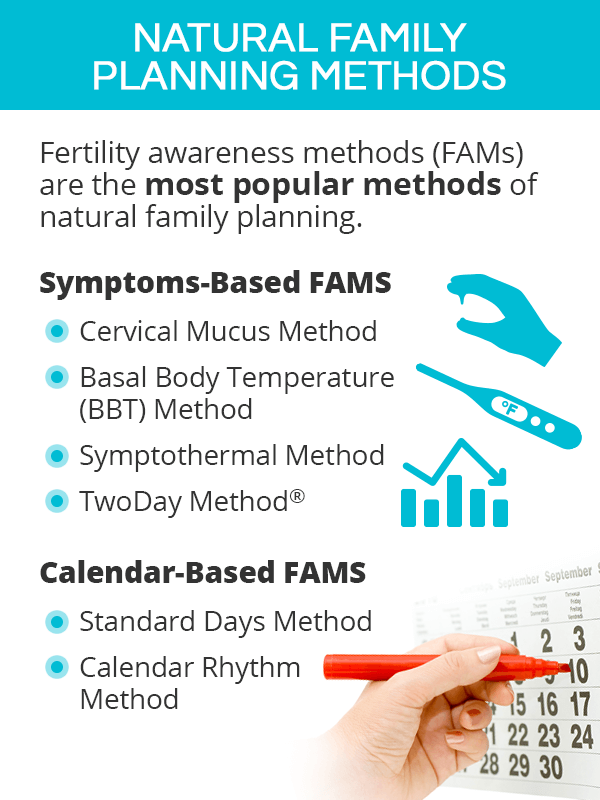About Natural Family Planning

Natural family planning is using knowledge of one's fertility to avoid having sex during fertile days and prevent pregnancy.
The same methods can be used by those who are preparing for pregnancy to identify the best days to have sex.
While women use fertility awareness as their sole method of contraception, they may also use it alongside other birth control methods for additional protection.
Additionally, doctors urge all women to pay attention to their menstrual cycles as a means of staying on top of their health, regardless of their reproductive status.
Fertility Overview
To use natural family planning to its full advantage, let's take a look at the basics of female fertility.1,2,3,4,5 This will make it easier to follow menstrual patterns.
- A healthy menstrual cycle lasts between 21 and 35 days, with 28 being the average.
- Ovulation takes place roughly in the middle of the cycle, about 14 days before the next cycle's period.
- The phase from the first day of a period and until ovulation is called the follicular phase.
- The phase from ovulation until the first day of the next period is called the luteal phase.
- Once released, the egg is available for fertilization for only 12 to 24 hours
- Sperm can survive inside the reproductive tract for up to five days.
- As such, a woman's fertile window occurs five days before ovulation and up to 24 hours after it.
It is worth keeping in mind that it will take at least three cycles to start seeing patterns. It may take longer and be more challenging for women with irregular periods.
Natural Family Planning Methods

Among various natural family planning methods, the most popularly used are fertility awareness methods (FAMs), also called fertility awareness-based (FAB) methods.6
The key task in using the fertility awareness method to prevent pregnancy is estimating when does a woman's ovulation take place. Once she determines when she is fertile, she will know when is it best to avoid having sex.
Symptoms-Based FAMS
- Cervical Mucus Method consists of checking cervical mucus for a clear and stretchy consistency that indicates the fertile window, during which sex should be avoided.
- Basal Body Temperature (BBT) Method involves measuring BBT upon waking to notice a small dip, followed by a small increase right around ovulation. Fertile days are 48 to 72 hours before that increase.
- Symphothermal Method combines various methods, most commonly BBT and mucus checks.
- TwoDay Method® is a variation of the cervical mucus method and involves doing mucus checks twice a day to record any secretions that day and the day before.
Calendar-Based FAMS
- Standard Days Method is applicable for women whose cycles are consistently between 26 and 32 days long. It considers days 8 to 19 as fertile.
- Calendar Rhythm Method entails calculating fertile and infertile days based on a woman's cycle length.
Natural planning may also include a withdrawal method, also called the pullout method. It consists of a man pulling the penis out of his partner's vagina before ejaculation.
Pros and Cons of Natural Family Planning

Natural family planning comes with a number of advantages that go beyond just women's reproductive health. However, they also come with certain limitations that may undermine its effectiveness.
Pros of Natural Family Planning
- Fertility awareness-based methods are free or involve very small costs.
- Since a woman does not take synthetic hormones, there are no side effects or increased health risks.
- It is a good option for women who do not want other birth control methods for religious reasons.
- There is no hindrance of a woman's fertility in the case she decides to get pregnant.
- Fertility awareness can help diagnose potential health-related abnormalities.
- It can be used alongside other birth control methods.
Cons of Natural Family Planning
- With typical use, natural family planning methods are 75-78% effective in preventing unplanned pregnancies.7,8
- Learning one's menstrual patterns takes time and ongoing diligence.
- Accuracy may be influenced by hormonal disorders, vaginal infections, or other illnesses.
- It does not protect against sexually transmitted diseases (STDs).
Key Takeaway
Natural family planning, consisting of various fertility awareness methods, involves determining a woman's fertile and infertile days. She will use these predictions to decide when to have sex and when to avoid it in order to prevent getting pregnant. Estimating ovulation and fertile window can be done by tracking menstrual patterns and recording ovulation signs and symptoms. Fertility awareness is free, causes no side effects, and does not affect fertility. It does, however, require high diligence and patience in order to learn one's patterns and bodily cues. Additionally, experts agree that knowledge of one's menstrual cycle is a must for all women, regardless of their reproductive status.
Sources
- CDC. (2017). Fertility Awareness-Based Methods. Retrieved November 9, 2020 from https://www.cdc.gov/reproductivehealth/contraception/mmwr/mec/appendixf.html
- Facts, Views & Vision. (2014). 'Fertility Awareness-Based Methods' and subfertility: a systematic review. Retrieved November 9, 2020 from https://www.ncbi.nlm.nih.gov/pmc/articles/PMC4216977/
- Health Direct. (2019). Fertility awareness (natural family planning). Retrieved November 9, 2020 from https://www.healthdirect.gov.au/fertility-awareness-natural-family-planning
- Human Reproduction. (2015). Fertility awareness online: the efficacy of a fertility education website in increasing knowledge and changing fertility beliefs. Retrieved November 9, 2020 from https://www.ncbi.nlm.nih.gov/pmc/articles/PMC4287305/
- Kaiser Family Foundation. (2018). Natural Family Planning as a Means of Preventing Pregnancy. Retrieved November 9, 2020 from https://www.kff.org/womens-health-policy/fact-sheet/natural-family-planning-as-a-means-of-preventing-pregnancy/
- Office on Women's Health. (2018). Trying to conceive. Retrieved November 9, 2020 from https://www.womenshealth.gov/pregnancy/you-get-pregnant/trying-conceive
- Stat Pearls. (2020). Natural Family Planning. Retrieved November 9, 2020 from https://www.ncbi.nlm.nih.gov/books/NBK546661/
Footnotes:
- The Society of Obstetricians and Gyneacologists of Canada. (n.d.). Normal Periods. Retrieved November 9, 2020 from https://www.yourperiod.ca/normal-periods/menstrual-cycle-basics/
- Informed Health.org. (2009). Heavy periods: Overview. Retrieved November 9, 2020 from https://www.ncbi.nlm.nih.gov/books/NBK279294/
- Clinical Evidence. (2012). Menorrhagia. Retrieved November 9, 2020 from https://www.ncbi.nlm.nih.gov/pmc/articles/PMC3285230/
- Better Health Channel. (2018). Ovulation. Retrieved November 9, 2020 from https://www.betterhealth.vic.gov.au/health/conditionsandtreatments/ovulation
- Cleveland Clinic. (2019). Abnormal Menstruation (Periods). Retrieved November 9, 2020 from https://my.clevelandclinic.org/health/diseases/14633-abnormal-menstruation-periods
- American Family Physician. (2012). Natural Family Planning. Retrieved November 9, 2020 from https://www.aafp.org/afp/2012/1115/p924.html
- Kaiser Family Foundation. (2018). Natural Family Planning. Retrieved November 9, 2020 from https://www.kff.org/womens-health-policy/fact-sheet/natural-family-planning-as-a-means-of-preventing-pregnancy/
- University of California, Davis. (n.d.). Fertility Awareness. Retrieved November 9, 2020 from https://shcs.ucdavis.edu/topics/fertility-awareness
